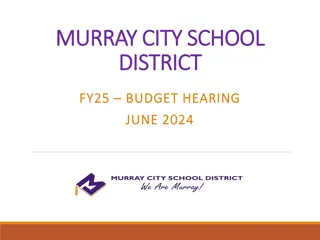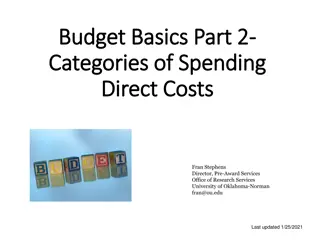Understanding the US Federal Budget Process
Explore the intricate details of the US federal budget process, including budget formulation, presentation, and execution. Learn about discretionary spending, agency budget development, and the multi-year budget trend. Discover the authority for the US budget as outlined in the US Constitution. Unveil the key terms and steps involved in the federal budgetary system.
Download Presentation

Please find below an Image/Link to download the presentation.
The content on the website is provided AS IS for your information and personal use only. It may not be sold, licensed, or shared on other websites without obtaining consent from the author. Download presentation by click this link. If you encounter any issues during the download, it is possible that the publisher has removed the file from their server.
E N D
Presentation Transcript
BLM Budget Process December NW RAC Meeting Amy Carmichael Colorado Northwest District Budget Analyst
Federal Budget Process (Simplified) Congress (Legislative) President (Executive) CBO OMB 5 Years out:Budget Blueprint Department Allowances Committee Caps Agency Allowances Hearings President s Budget Sends to Congress OMB House/Senate Mark-up Forest Service Allowance H/S Subcommittee Reports Congress says DOA & negotiations start Dept./Agency Appeal Chief s Office House/Senate Conference Dept./Agency Pass Back Final Appropriations Bill with Earmarks Appropriations Bill Passes H/S Chief s Programs Deputy Chief Requests OMB Review Agreements Field Requests President Signs Department Budget Office Agency Budgets Agency Request
Objectives Describe the federal budget process Describe how agency budgets are developed and executed Discuss multi-year budget trend
Important Terms Discretionary Spending: Discretionary spending is that part of the U.S. Federal Budget that is negotiated between the President and Congress each year as part of the budget process. It includes everything that is not in the mandatory budget, which are programs required by law to provide certain benefits, such as Social Security and Medicare.
Important Terms cont. Budget Formulation: Developing the President s budget Budget Presentation: Explaining/defending the budget to congress Budget Execution: Distributing the dollars and completing the work
Where is the Authority for the US Budget? US Constitution, Article 1, Section 1: All legislative powers herein granted shall be vested in a Congress of the United States, which shall consist of a Senate and House of Representatives. Article 1, Section 7: All bills for raising revenue shall originate in the House of Representatives; but the Senate may propose or concur with amendments as on other bills.
Where is the Authority for the US Budget? US Constitution, Article 1, Section 7: Every bill which shall have passed the House of Representatives and the Senate, shall, before it becomes law, be presented to the President of the United States. Article 1, Section 8: The Congress shall have the power to lay and collect taxes [and] to pay [the] debts of the United States.
Where is the Authority for the US Budget? Article 1, Section 9: No money shall be drawn from the treasury, but in consequence of appropriations made by law
What does this mean? Congress authorizes and appropriates money The President and Congress must reach agreement The President can only ask Congress for money Appropriation bills are law, not guidelines
The Federal DollarWhere did it go? President s Budget 2016 Social Security 20% 2016 Discretionary 17% Defense 18% Medicare 15% Debt Interest 7% Medicaid 9% Other Entitlements 14%
Budget Process - Timeframe FY 2017 Budget FY 2018 Budget FY 2019 Budget
Budget Creation Recap President submits annual budget (Feb 1) Congress receives budget; immediately signals intent to amend it Congressional process begins in the House Authorization Committee hearings Appropriation Committee hearings Floor debate
Recap Continues Senate consideration-similar process Conference Committee to negotiate differences and agree on a budget Congress sends budget to the President for signature or veto (by Sept 30) But what if they can t agree?
Continuing Resolutions Tool to provide funding in the absence of an adopted budget 1977-2016 only 4 budgets were adopted Promotes stalemate gives Congress an out Creates uncertainty, distorted spending and lost productivity
13 Regular Appropriations Bills Agricultural, Rural Development, FDA, & related agencies Commerce, Justice, Science & related agencies Defense Energy and Water Development Financial Services and General Government Homeland security Interior, Environment & related agencies Labor, Health and Human services, Education Legislative branch Military Construction, Veterans Affairs State and Foreign Operations Transportation, Housing and Urban Development Select Intelligence Oversight Panel
Budget Process for BLM Money for the BLM comes from a Subcommittee of the Appropriations committee called Interior, Environment and Related Agencies . The Interior, Environment and Related Agencies appropriations bill funds about 35 different agencies, including DOI, the Forest Service, the Smithsonian Institution, the National Endowment for the Arts, plus many other museums and cultural institutions.
Process to the Field WO DOI-BLM Budget Office Colorado State BLM Office NW District Office Field Office
The Discretionary component of Federal spending has decreased as Mandatory spending increases Mandatory Federal Spending has almost tripled, from 26% of the entire Federal budget in 1962 to 59% in 2013. As a result, less money remains for Discretionary programs such as the Forest Service and DOI.
USDA and DOI accounts for only 3% of Federal Discretionary Appropriations Composition of 2009 President's Budget Interior 1% Agriculture 2% Defense 57% Other Departments 40%
2016 DOI Budget Allocation OSM, 1% MMS, 2% BOR, 9% BLM, 9% USGS, 9% Other, 11% OST, 1% FWS, 14% BIA, 21% NPS, 23%
Of That 9%... Over 50 different program areas are appropriated Each program has specific direction on how it can be spent Each appropriation must be spent to 2% by the end of fiscal We manage almost 60 other non- appropriated accounts Rec, grazing, realty, Oil & Gas application and royalties, grant and matching funds, etc.
NW District $ FY 10 to FY 16 Trend Appropriated Funds $30,000,000 $24,322,783 $25,000,000 $21,894,320 $20,179,470 $18,841,187 $20,000,000 $18,039,537 $17,871,209 $17,218,868 $15,000,000 $10,000,000 $5,000,000 $- FY 10 FY 11 FY 12 FY 13 FY 14 FY 15 FY 16 Series9 $24,322,783 $21,894,320 $18,039,537 $17,218,868 $18,841,187 $17,871,209 $20,179,470
Recreation Funding Trend FY12 FY13 FY14 FY15 FY16 % Change L1220 937,131 841,012 807,793 780,076 730,785 -22.02% L1232 336,027 448,336 515,605 562,863 625,090 86.02% 1,273,158 1,289,348 1,323,398 1,342,939 1,355,875 6.50%
Objectives Describe the federal budget process Describe how agency budgets are developed and executed Discuss multi-year budget trend























